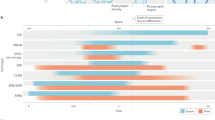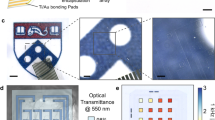Abstract
The brain is a dynamic structure with the extracellular space (ECS) taking up almost a quarter of its volume1,2. Signalling molecules, neurotransmitters and nutrients transit via the ECS, which constitutes a key microenvironment for cellular communication3 and the clearance of toxic metabolites. The spatial organization of the ECS varies during sleep4, development5 and aging6 and is probably altered in neuropsychiatric and degenerative diseases7, as inferred from electron microscopy8,9 and macroscopic biophysical investigations2,10. Here we show an approach to directly observe the local ECS structures and rheology in brain tissue using super-resolution imaging. We inject single-walled carbon nanotubes into rat cerebroventricles and follow the near-infrared emission of individual nanotubes as they diffuse inside the ECS for tens of minutes in acute slices. Because of the interplay between the nanotube geometry and the ECS local environment, we can extract information about the dimensions and local viscosity of the ECS. We find a striking diversity of ECS dimensions down to 40 nm, and as well as of local viscosity values. Moreover, by chemically altering the extracellular matrix of the brains of live animals before nanotube injection, we reveal that the rheological properties of the ECS are affected, but these alterations are local and inhomogeneous at the nanoscale.
This is a preview of subscription content, access via your institution
Access options
Subscribe to this journal
Receive 12 print issues and online access
$259.00 per year
only $21.58 per issue
Buy this article
- Purchase on Springer Link
- Instant access to full article PDF
Prices may be subject to local taxes which are calculated during checkout




Similar content being viewed by others
References
Cserr, H. F. et al. Extracellular volume decreases while cell volume is maintained by ion uptake in rat-brain during acute hypernatremia. J. Physiol. 442, 277–295 (1991).
Syková, E. & Nicholson, C. Diffusion in brain extracellular space. Physiol. Rev. 88, 1277–1340 (2008).
Dityatev, A., Schachner, M. & Sonderegger, P. The dual role of the extracellular matrix in synaptic plasticity and homeostasis. Nat. Rev. Neurosci. 11, 735–746 (2010).
Xie, L. et al. Sleep drives metabolite clearance from the adult brain. Science 342, 373–377 (2013).
Lehmenkühler, A., Sykova, E., Svoboda, J., Zilles, K. & Nicholson, C. Extracellular space parameters in the rat neocortex and subcortical white matter during postnatal development determined by diffusion analysis. Neuroscience 55, 339–351 (1993).
Metzler-Baddeley, C., Jones, D. K., Belaroussi, B., Aggleton, J. P. & O'Sullivan, M. J. Frontotemporal connections in episodic memory and aging: a diffusion MRI tractography study. J. Neurosci. 31, 13236–13245 (2011).
Berezin, V., Walmod, P. S., Filippov, M. & Dityatev, A. Targeting of ECM molecules and their metabolizing enzymes and receptors for the treatment of CNS diseases. Prog. Brain Res. 214, 353–388 (2014).
Ohno, N., Terada, N., Saitoh, S. & Ohno, S. Extracellular space in mouse cerebellar cortex revealed by in vivo cryotechnique. J. Comp. Neurol. 505, 292–301 (2007).
Korogod, N., Petersen, C. C. & Knott, G. W. Ultrastructural analysis of adult mouse neocortex comparing aldehyde perfusion with cryo fixation. eLife 4, e05793 (2015).
Verkman, A. S. Diffusion in the extracellular space in brain and tumors. Phys. Biol. 10, 045003 (2013).
Welsher, K. et al. A route to brightly fluorescent carbon nanotubes for near-infrared imaging in mice. Nat. Nanotech. 4, 773–780 (2009).
Heller, D. A. et al. Multimodal optical sensing and analyte specificity using single-walled carbon nanotubes. Nat. Nanotech. 4, 114–120 (2009).
Bachilo, S. M. et al. Structure-assigned optical spectra of single-walled carbon nanotubes. Science 298, 2361–2366 (2002).
Cognet, L. et al. Stepwise quenching of exciton fluorescence in carbon nanotubes by single-molecule reactions. Science 316, 1465–1468 (2007).
Reuel, N. F., Dupont, A., Thouvenin, O., Lamb, D. C. & Strano, M. S. Three-dimensional tracking of carbon nanotubes within living cells. ACS Nano 6, 5420–5428 (2012).
Fakhri, N. et al. High-resolution mapping of intracellular fluctuations using carbon nanotubes. Science 344, 1031–1035 (2014).
Wang, Y., Bahng, J. H., Che, Q., Han, J. & Kotov, N. A. Anomalously fast diffusion of targeted carbon nanotubes in cellular spheroids. ACS Nano 9, 8231–8238 (2015).
Jena, P. V. et al. Photoluminescent carbon nanotubes interrogate the permeability of multicellular tumor spheroids. Carbon 97, 99–109 (2016).
Fakhri, N., MacKintosh, F. C., Lounis, B., Cognet, L. & Pasquali, M. Brownian motion of stiff filaments in a crowded environment. Science 330, 1804–1807 (2010).
Varela, J. A. et al. Targeting neurotransmitter receptors with nanoparticles in vivo allows single-molecule tracking in acute brain slices. Nat. Commun. 7, 10947 (2016).
Liu, Z. et al. In vivo biodistribution and highly efficient tumour targeting of carbon nanotubes in mice. Nat. Nanotech. 2, 47–52 (2007).
Gao, Z., Varela, J. A., Groc, L., Lounis, B. & Cognet, L. Toward the suppression of cellular toxicity from single-walled carbon nanotubes. Biomater. Sci. 4, 230–244 (2016).
Santos, S. M. et al. All-optical trion generation in single-walled carbon nanotubes. Phys. Rev. Lett. 107, 187401 (2011).
Thorne, R. G. & Nicholson, C. In vivo diffusion analysis with quantum dots and dextrans predicts the width of brain extracellular space. Proc. Natl Acad. Sci. USA 103, 5567–5572 (2006).
Han, Y. et al. Brownian motion of an ellipsoid. Science 314, 626–630 (2006).
Schutz, G. J., Schindler, H. & Schmidt, T. Single-molecule microscopy on model membranes reveals anomalous diffusion. Biophys. J. 73, 1073–1080 (1997).
Tardin, C., Cognet, L., Bats, C., Lounis, B. & Choquet, D. Direct imaging of lateral movements of AMPA receptors inside synapses. EMBO J. 22, 4656–4665 (2003).
Kusumi, A., Sako, Y. & Yamamoto, M. Confined lateral diffusion of membrane receptors as studied by single particle tracking (nanovid microscopy): effects of calcium-induced differentiation in cultured epithelial cells. Biophys. J. 65, 2021–2040 (1993).
Godin, A. G., Lounis, B. & Cognet, L. Super-resolution microscopy approaches for live cell imaging. Biophys. J. 107, 1777–1784 (2014).
Kochlamazashvili, G. et al. The extracellular matrix molecule hyaluronic acid regulates hippocampal synaptic plasticity by modulating postsynaptic L-type Ca(2+) channels. Neuron 67, 116–128 (2010).
Stoppini, L., Buchs, P. A. & Muller, D. A simple method for organotypic cultures of nervous tissue. J Neurosci. Methods 37, 173–182 (1991).
Haas, K., Sin, W. C., Javaherian, A., Li, Z. & Cline, H. T. Single-cell electroporation for gene transfer in vivo. Neuron 29, 583–591 (2001).
Oudjedi, L., Parra-Vasquez, A. N., Godin, A. G., Cognet, L. & Lounis, B. Metrological investigation of the (6,5) carbon nanotube absorption cross section. J. Phys. Chem. Lett. 4, 1460–1464 (2013).
Meijering, E. et al. Design and validation of a tool for neurite tracing and analysis in fluorescence microscopy images. Cytometry A 58, 167–176 (2004).
Han, Y., Alsayed, A., Nobili, M. & Yodh, A. G. Quasi-two-dimensional diffusion of single ellipsoids: aspect ratio and confinement effects. Phys. Rev. E 80, 011403 (2009).
Acknowledgements
We thank E. Bézard, M. Blanchard-Desce, B. Bontempi and P. Bon for helpful discussions. We thank the Bordeaux Imaging Center (service unit of the CNRS-INSERM and Univ. Bordeaux). We thank J.P. Salvetat for experimental help with AFM imaging and J. Ferreira for support with histological experiments. This work was supported by CNRS, the Agence Nationale de la Recherche (ANR-14-OHRI-0001-01), IdEx Bordeaux (ANR-10-IDEX-03-02), Labex Brain (ANR-10-LABX-43), Conseil Régional d'Aquitaine (2011-1603009) and the France-BioImaging national infrastructure (ANR-10-INBS-04-01). A.G.G. acknowledges financial support from the Fondation pour la Recherche Médicale and the Fonds Recherche du Québec–Nature et Technologies. J.A.V. acknowledges funding from Marie Curie Individual Fellowship 326442.
Author information
Authors and Affiliations
Contributions
A.G.G., J.A.V., Z.G. and J.P.D. performed the experiments. A.G.G., N.D., B.L. and L.C. performed the analysis. B.L., L.G. and L.C. co-supervised the study. L.G. and L.C. designed the study. All authors discussed the results and co-wrote the manuscript.
Corresponding authors
Ethics declarations
Competing interests
The authors declare no competing financial interests.
Supplementary information
Supplementary information
Supplementary information (PDF 1852 kb)
Supplementary Movie 1
Supplementary Movie 1 (MP4 3474 kb)
Supplementary Movie 2
Supplementary Movie 2 (MP4 11051 kb)
Rights and permissions
About this article
Cite this article
Godin, A., Varela, J., Gao, Z. et al. Single-nanotube tracking reveals the nanoscale organization of the extracellular space in the live brain. Nature Nanotech 12, 238–243 (2017). https://doi.org/10.1038/nnano.2016.248
Received:
Accepted:
Published:
Issue Date:
DOI: https://doi.org/10.1038/nnano.2016.248
This article is cited by
-
Circulating myeloid-derived MMP8 in stress susceptibility and depression
Nature (2024)
-
Imaging brain tissue architecture across millimeter to nanometer scales
Nature Biotechnology (2023)
-
Amyloid-β slows cilia movement along the ventricle, impairs fluid flow, and exacerbates its neurotoxicity in explant culture
Scientific Reports (2023)
-
Deep learning for diffusion in porous media
Scientific Reports (2023)
-
Human and environmental safety of carbon nanotubes across their life cycle
Nature Reviews Materials (2023)



